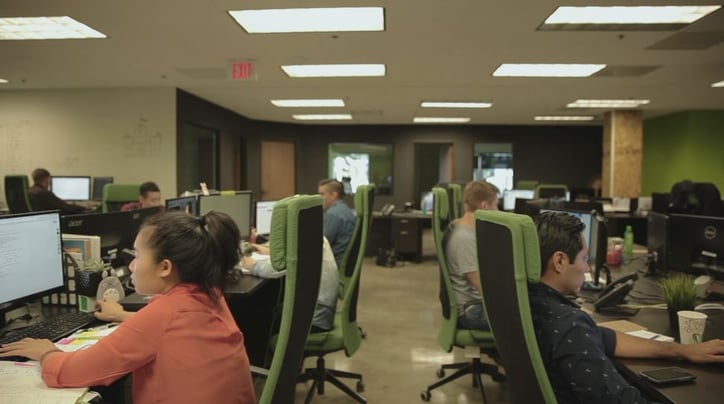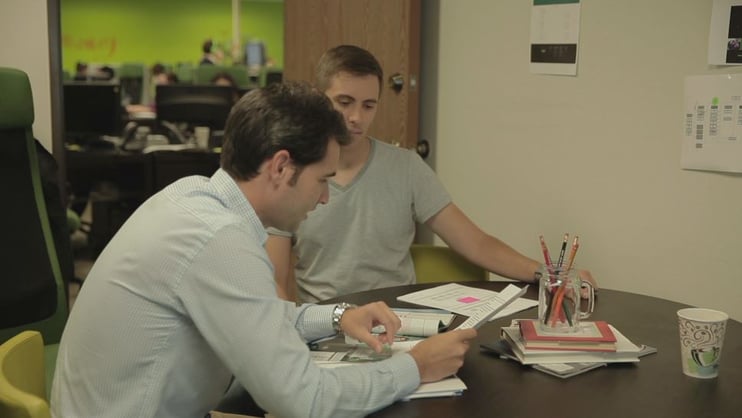Manish Patel | Oct 23, 2015 10:00:00 AM
3 Min Read

What does the perfect workspace look like? Maybe it’s a huge, dark wooden desk overlooking downtown, or maybe it’s an open area filled with couches and brightly colored pictures and lamps. Maybe it’s a place you wouldn’t normally associate with work—like your house or a coffee shop. Whatever your image of the ideal workspace is, there is the type of office that encourages innovation, and there is the type of office that drains it out of us.
The days of “office jail” are over as so many businesses are now taking a creative approach to their office structure. Science has proven there are certain aspects to this idea that allow ourselves and our employees to feel more driven and satisfied. In 2011, a group of undergraduates were asked to rate room interiors with edged furniture and those with curved furniture. Those who conducted the study found that room interiors featuring curved objects were favored over those rooms with straight-edged rectilinear environments. Not only that, but rounded environments were also proven to cause more activity in brain regions than rectilinear rooms. It looks like King Arthur may have been on to something.
About two years ago, we brought down the walls at my office. It was a risky decision because everyone was comfortable in their closed-off little areas. So why did we do it? In search of a more collaborative space. The first few months were tough, and I remember employees hovering over their phones in fear that someone would overhear their conversations. It was a huge change in culture that happened almost overnight. One week the office was status quo, the next week it was completely transformed—and that can be a bit unsettling at first.
Now, we might not have started putting circular desks everywhere, but we ripped up the carpeting, implemented brighter lighting and put up walls that employees could write on. We completely changed the makeup of the office, and you know what? Once everyone got settled in, it changed the makeup of the team. Here’s how revamping the workspace benefited our workforce.

It built trust & collaboration
It took months for people to feel comfortable with this change, but I know not one of them would want to go back. Employees are now free from the walls that inhibited inclusion. An organization’s workforce is a part of the same brand and—more importantly—the same team, so they need to be able to trust each other and feel a certain level of comfort with one another. By tearing down the walls, we created an inclusive space that allowed everyone to open up.
Do you know what happened after that? People were talking. They were leaning over and asking each other questions and offering advice. Now that they felt comfortable, knew each other better and trusted each other, the team functioned like a cohesive unit through collaboration.
It increased productivity
The new inclusive, creative space made productivity soar. Why? Turns out the increase in chance encounters actually improved individual and team performance; and that isn’t just at our workplace. Scott Birnbaum, vice president of Samsung Semiconductor once said, “The most creative ideas aren’t going to come while sitting in front of your monitor.” He’s seen success with an open-space environment that creates a way for employees to bump into each other throughout the day. Informal conversations are part of communication, and though we use chat or email, sometimes the best way to really connect is by getting out of our chairs and having a face-to-face exchange.
Allow creativity to unfold by taking a risk and tearing down your own walls. Provide your team with an environment that is rich with collaboration because when they can enjoy what they do they will be more creative.
This article was originally posted on Business 2 Community. Read it here.
Topics: Manishologies

Manish Patel is founder and CEO of Brandify.
Offer Post Justifications Spotted in Local Results
Oct 4, 2021 8:47:46 AM
Monday Memo: More than Brands and Influencers, Consumers Trust Each Other
Sep 27, 2021 7:56:34 AM
Monday Memo: Google Adds “Latino-Owned” to GMB Identity Attributes
Sep 20, 2021 7:58:58 AM
Monday Memo: New Study Shows 94% of Consumers Use Online Business Directories
Sep 13, 2021 7:16:55 AM
Monday Memo: The Page Experience Update Has Fully Rolled Out
Sep 6, 2021 7:43:45 AM